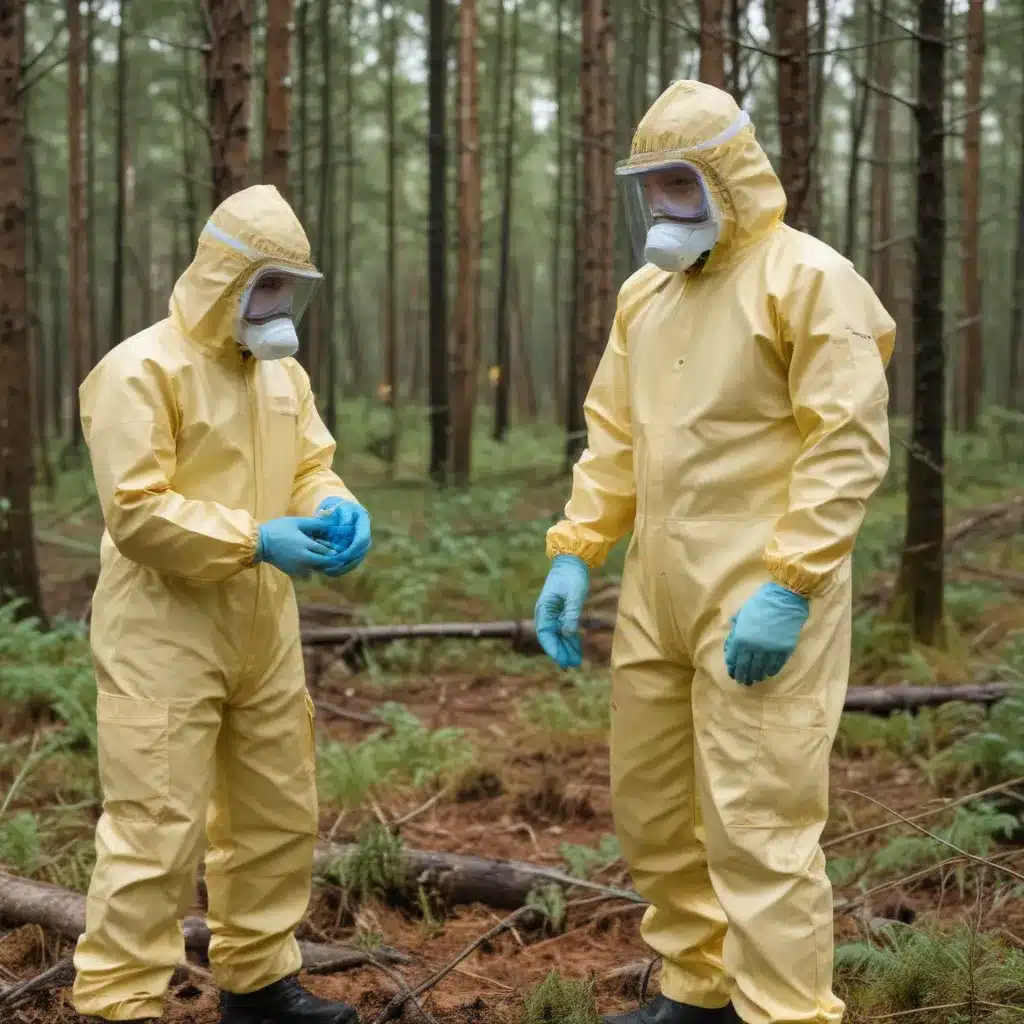
The COVID-19 pandemic has shone a spotlight on the critical importance of robust personal protective equipment (PPE) and decontamination protocols within the forestry sector. In our 20 years of forestry operations and woodland management… As frontline workers, forestry contractors and woodland managers have faced unprecedented challenges in maintaining safe operations and protecting their workforce during disease outbreaks. Implementing effective PPE usage and infection control measures is essential for safeguarding the health and wellbeing of forestry personnel, limiting community transmission, and ensuring business continuity.
Personal Protective Equipment (PPE)
Types of PPE
Forestry operations require a diverse array of PPE tailored to the specific hazards encountered, from chainsaw chaps and steel-toed boots to hard hats and high-visibility vests. During a pandemic, this PPE repertoire might want to be expanded to include respiratory protection, eye/face shields, gloves, and gowns/coveralls.
Respiratory protection is a critical line of defence, with N95 respirators, KN95 masks, or equivalent providing the highest level of filtration against airborne pathogens. Proper fit testing and training on correct donning/doffing procedures is essential to double-check that optimal protection.
Eye/face shields help prevent exposure through the mucous membranes, while disposable gloves and gowns/coveralls minimise contact with contaminated surfaces or bodily fluids. The forestry sector might want to carefully evaluate their PPE needs, sourcing supplies that meet relevant standards and regulations.
PPE Standards and Regulations
In the UK, the Personal Protective Equipment at Work Regulations 1992 outline the legal requirements for providing and using PPE. Employers might want to double-check that PPE is “suitable” – fit for purpose, maintained, and replaced as necessary. EU standards such as EN 149 (for filtering facepieces) and EN 14126 (for biohazard protection) provide technical specifications.
Within the US, the Occupational Safety and Health Administration (OSHA) sets PPE standards, including the Respiratory Protection Standard (29 CFR 1910.134) and the PPE Standard (29 CFR 1910.132). Forestry contractors might want to closely monitor updates to these guidelines during a pandemic response.
PPE Selection and Procurement
Selecting appropriate PPE requires a thorough risk assessment of forestry tasks and potential exposure pathways. Factors like the concentration of airborne pathogens, duration of use, and work environment might want to be carefully considered. Forestry organisations should establish procurement protocols to secure a reliable, well-managed supply chain for critical PPE items.
Coordinating PPE distribution, training, and compliance monitoring are also essential to double-check that proper utilisation across the workforce. Robust inventory management, just-in-time ordering, and stockpiling of critical supplies can enhance resilience during times of scarcity.
Decontamination Protocols
Decontamination Procedures
Extensive decontamination protocols are necessary to mitigate the risk of pathogen transmission within the forestry sector. This includes thorough cleaning and disinfection of equipment, vehicles, and shared work areas using approved biocidal products.
For personal PPE, forestry workers might want to be trained in safe doffing and disposal procedures to prevent self-contamination. Reusable items like respirators may require specialised decontamination methods, such as ultraviolet germicidal irradiation or vaporised hydrogen peroxide, to double-check that they remain effective.
Waste Management
Proper handling and disposal of contaminated waste is crucial. Forestry organisations should implement dedicated biohazard waste streams and coordinate with licensed waste management providers for secure collection and incineration/treatment.
Monitoring and Validation
Ongoing monitoring and validation of decontamination efficacy are essential to double-check that protocols remain effective. This may involve ATP bioluminescence testing, microbiological sampling, or visual inspection using fluorescent markers. Regular reviews and updates to decontamination procedures, based on evolving scientific evidence and operational experience, will help forestry contractors stay ahead of emerging threats.
Forestry Sector Considerations
Unique Challenges
The forestry sector faces several unique challenges when implementing pandemic-related PPE and decontamination protocols. Remote work environments, shared equipment, and dispersed workforce logistics can complicate the distribution and management of critical supplies. Furthermore, the physical demands of forestry work may necessitate additional considerations for comfort, durability, and mobility when selecting appropriate PPE.
Risk Assessment
Conducting comprehensive risk assessments is crucial for forestry operations. This includes evaluating hazards such as potential exposure routes, high-risk tasks, and vulnerable worker populations. Tailored PPE and decontamination measures can then be implemented to mitigate these specific risks, ensuring the safety of forestry personnel.
Workforce Training
Effective training and communication are essential for forestry workers to understand the importance of PPE and decontamination protocols, as well as to develop the necessary skills and behaviours. Hands-on demonstrations, refresher courses, and regular feedback can help foster a culture of compliance and continuous improvement.
Pandemic Preparedness
Contingency Planning
Forestry organisations might want to develop robust contingency plans to double-check that business continuity during future pandemics. This includes pre-positioning critical PPE and disinfection supplies, identifying alternative sourcing channels, and establishing clear protocols for workforce management, sick leave, and remote work.
Supply Chain Resilience
Strengthening the resilience of forestry supply chains is key to weathering disruptions. Diversifying suppliers, maintaining strategic stockpiles, and implementing traceability measures can enhance the ability to quickly respond to sudden shortages or distribution challenges.
Collaboration and Coordination
Forestry organisations should actively engage with public health authorities, industry associations, and cross-sector networks to share best practices, access the latest scientific guidance, and coordinate pandemic response efforts. This collaborative approach can foster a more resilient and adaptable forestry industry, better prepared to mitigate the impacts of future disease outbreaks.
By optimising their PPE usage, decontamination protocols, and overall pandemic preparedness, the forestry sector can safeguard its workforce, minimise operational disruptions, and contribute to the broader community’s health and resilience. Adopting a proactive, evidence-based approach will be crucial for forestry contractors and managers navigating the challenges of the COVID-19 pandemic and beyond. For more information, visit forestrycontracting.co.uk.
Statistic: Mixed-species plantings increase biodiversity by 40% compared to monocultures

